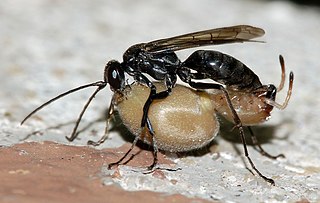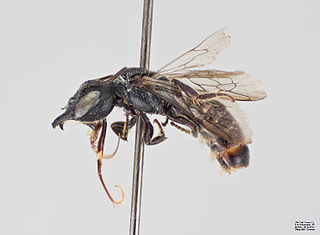
Pison is a cosmopolitan genus of wasps within the family Crabronidae. The genus comprises 145 described species, although many species, especially in South America remain undescribed.

Melitta is a genus of bees in the family Melittidae. It includes about 40 species restricted to Africa and the northern temperate zone. Most of the species are Palaearctic, though three rare species occur in North America.

The cosmopolitan bee genus Ceratina, often referred to as small carpenter bees, is the sole lineage of the tribe Ceratinini, and is not closely related to the more familiar carpenter bees. The genus presently contains over 300 species in 23 subgenera. They make nests in dead wood, stems, or pith, and while many are solitary, a number are subsocial, with mothers caring for their larvae, and in a few cases where multiple females are found in a single nest, daughters or sisters may form very small, weakly eusocial colonies. One species is unique for having both social and asocial populations, Ceratina australensis, which exhibits all of the pre-adaptations for successful group living. This species is socially polymorphic with both solitary and social nests collected in sympatry. Social colonies in that species consist of two foundresses, one contributing both foraging and reproductive effort and the second which remains at the nest as a passive guard. Cooperative nesting provides no overt reproductive benefits over solitary nesting in this population, although brood survival tends to be greater in social colonies. Maternal longevity, subsociality and bivoltine nesting phenology in this species favour colony formation, while dispersal habits and offspring longevity may inhibit more frequent social nesting in this and other ceratinines.

Auplopus is a large genus of spider wasps belonging to the subfamily Pepsinae of the spider wasp family Pompilidae, distributed throughout the world except for Antarctica. Auplopus wasps amputate the legs of their spider prey before transporting it to the nest.

Gorytes is a genus of sand wasps in the family Bembicidae. There are at least 70 described species in Gorytes.

Batozonellus is a genus of the spider hunting wasps.

Argogorytes is a genus of wasps in the family Bembicidae, with 31 known species. The genus is found around the world, with the exception of tropical Africa and Antarctica.

Aphrophora is a genus of spittlebugs in the family Aphrophoridae. There are at least 80 described species in Aphrophora.
Epinysson is a genus of kleptoparasitic wasps in the family Bembicidae. There are more than 20 described species in Epinysson.

Hoplisoides is a genus of sand wasps in the family Bembicidae. There are at least 70 described species in Hoplisoides.
Macrocephalus is a genus of ambush bugs in the family Reduviidae. There are more than 30 described species in Macrocephalus.

Ibalia is a genus of ibaliid wasps in the family Ibaliidae. There are about 14 described species in Ibalia. All species are parasitoids of Siricidae species, which they seek out by detecting volatiles emitted by the fungi Siricidae larvae feed on, Amylostereum.
Didineis is a genus of wasps in the family Bembicidae. There are more than 20 described species in Didineis.

Alysson is a genus of hymenopterans in the family Bembicidae. There are at least 40 described species in Alysson.

Phyrdenus is a genus of hidden snout weevils in the beetle family Curculionidae. There are more than 20 described species in Phyrdenus.

Microbembex is a genus of sand wasps in the family Bembicidae. There are more than 30 described species in Microbembex.
Glenostictia is a genus of sand wasps in the family Bembicidae. There are more than 20 described species in Glenostictia.
Lestiphorus cockerelli is a species of sand wasp in the family Bembicidae. It is found in North America.
Lophoscutus is a genus of ambush bugs in the family Reduviidae. There are more than 60 described species in Lophoscutus.

Protosmia is a genus of subgenus Chelostomopsis in the family Megachilidae. There are more than 30 described species in Protosmia.















